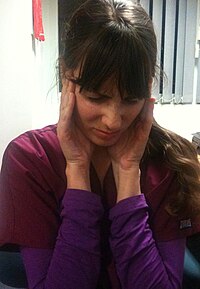
Photo from wikipedia
Migraine and tension-type headache (TTH) are often viewed as distinct entities and defined as such in the International Classification of Headache Disorders, 2nd edition (ICHD-II) criteria, although there is also… Click to show full abstract
Migraine and tension-type headache (TTH) are often viewed as distinct entities and defined as such in the International Classification of Headache Disorders, 2nd edition (ICHD-II) criteria, although there is also empirical evidence to suggest they may be etiologically similar. This study aims to investigate whether migraine and TTH are etiologically related conditions. First, we explored whether migraine and TTH were associated with the same environmental and lifestyle risk factors at the population level. Second, we examined comorbidity of migraine and TTH in a twin design. By comparing the associations in monozygotic (MZ) and dizygotic (DZ) twin pairs, we investigated whether the comorbidity can be explained by genetic factors that influence both conditions. Results indicated that migraine and TTH were largely associated with the same environmental and lifestyle factors, including younger age, female sex, higher body mass index, more depression, stress at home, and less participation in regular exercise, with consistently stronger effects for migraine than for TTH. Migraine in one twin was significantly associated with TTH in the other twin. A stronger cross-trait, cross-twin association in MZ than DZ twins suggested that this comorbidity may also be partly due to shared genetic factors, although the difference in associations was not significant. In conclusion, our findings are consistent with the hypothesis that migraine and TTH have partly shared etiologies. For both treatment and research, it may be advisable not to make a rigid distinction, but to treat migraine and TTH as related conditions.
Journal Title: Twin Research and Human Genetics
Year Published: 2018
Link to full text (if available)
Share on Social Media: Sign Up to like & get
recommendations!